Prestressed Concrete | RCC & Prestressed Concrete - Civil Engineering (CE) PDF Download
Introduction
- Prestress is defined as a method of applying pre-compression to control the stresses resulting due to external loads below the neutral axis of the beam tension developed due to an external load that is more than the permissible limits of the plain concrete.
- Prestressed concrete is basically concrete in which internal stresses of a suitable magnitude and distribution are introduced so that the stresses resulting from the external loads are counteracted to a desired degree.
Terminology
- Tendon: A stretched element used in a concrete member of the structure to impart prestress to the concrete.
- Anchorage: A device generally used to enable the tendon to impart and maintain prestress in concrete.
- Pre tensioning: A method of prestressing concrete in which the tendons are tensioned before the concrete is placed. In this method, the concrete is introduced by the bond between steel & concrete.
- Post-tensioning: A method of prestressing concrete by tensioning the tendons against hardened concrete. In this method, the prestress is imparted to concrete by bearing
Materials for prestressing concrete members
- Cement: The cement used should be any of the following
(i) Ordinary Portland cement conforming to IS269
(ii) Portland slag cement conforming to IS455. But the slag content should not be more than 50%.
(iii) Rapid hardening Portland cement conforming to IS8041.
(iv) High strength ordinary Portland cement conforming to IS8112. - Concrete: Prestress concrete requires concrete, which has a high compressive strength reasonably early age with comparatively higher tensile strength than ordinary concrete. The concrete for the members shall be air-entrained concrete composed of Portland cement, fine and coarse aggregates, admixtures and water. The air-entraining feature may be obtained by the use of either air-entraining Portland cement or an approved air-entraining admixture. The entrained air content shall be not less than 4 per cent or more than 6 per cent.
(i) Minimum cement content of 300 to 360 kg/m3 is prescribed for the durability requirement.
(ii) The water content should be as low as possible. - Steel: High tensile steel, tendons, strands or cables
High strength steel should contain:
(i) 0.7 to 0.8% carbons,
(ii) 0.6% manganese,
(iii) 0.1% silica
Why high grade of concrete & steel?
- Higher the grade of concrete higher the bond strength which is vital in pre-tensioned concrete.
- Also, higher bearing strength which is essential in post-tensioned concrete as well as in pre-tensioned concrete.
- Creep & shrinkage losses are minimum with high-grade concrete.
- Generally, minimum M30 grade concrete is used for post-tensioned & M40 grade concrete is used for pre-tensioned members.
- The losses in pre-stress members due to various reasons are generally in the range of 250 N/mm2 to 400 N/mm2
- If mild steel or deformed steel is used the residual stresses after losses are either zero or negligible.
Advantage of Prestressed Concrete
- The use of high strength concrete and steel in prestressed members results in lighter and slender members than is possible with RC members.
- In fully prestressed members the member is free from tensile stresses under working loads, thus the whole of the section is effective.
- In prestressed members, dead loads may be counter-balanced by eccentric prestressing.
- Prestressed concrete member possesses better resistance to shear forces due to the effect of compressive stresses presence or eccentric cable profile.
- Use of high strength concrete and freedom from cracks, contribute to improving durability under aggressive environmental conditions.
- Long span structures are possible so that saving in weight is significant & thus it will be economic.
- Factory products are possible.
- Prestressed members are tested before use.
- Prestressed concrete structure deflects appreciably before ultimate failure, thus giving ample warning before the collapse.
- Fatigue strength is better due to small variations in prestressing steel, recommended to dynamically loaded structures.
Disadvantages of Prestressed Concrete
- The availability of experienced builders is scanty.
- Initial equipment cost is very high.
- Availability of experienced engineers is scanty.
- Prestressed sections are brittle
- Prestressed concrete sections are less fire-resistant.
Classifications and Types
Prestressed concrete structures can be classified in a number of ways depending upon the feature of designs and constructions.
- Pre-tensioning: In which the tendons are tensioned before the concrete is placed, tendons are temporarily anchored and tensioned and the prestress is transferred to the concrete after it is hardened.
- Post-tensioning: In which the tendon is tensioned after the concrete has hardened. Tendons are placed in sheathing at suitable places in the member before casting and later after hardening of concrete.
Tensioning Devices
- Mechanical devices: The mechanical devices generally used include weights with or without lever transmission, geared transmission in conjunction with pulley blocks, screw jacks with or without gear devices and wire-winding machines.
- Hydraulic devices: These are the simplest means for producing large prestressing force, extensively used as tensioning devices
- Electrical devices: The wires are electrically heated and anchored before placing concrete in the mould. This method is often referred to as thermo-prestressing and used for tensioning steel wires and deformed bars.
- Chemical devices: Expanding cement are used and the degree of expansion is controlled by varying the curing condition. Since the expansive action of cement, while the setting is restrained, induces tensile forces in tendons and compressive stresses in concrete.
Prestressing System
- Pretensioning system: In the pre-tensioning systems, the tendons are first tensioned between the rigid anchor-blocks cast on the ground or in a column or unit –mould types pre-tensioning bed, before the casting of concrete in the mould. The tendons comprising individual wires or strands are stretched with constant eccentricity or a variable eccentricity with tendon anchorage at one end and jacks at the other.
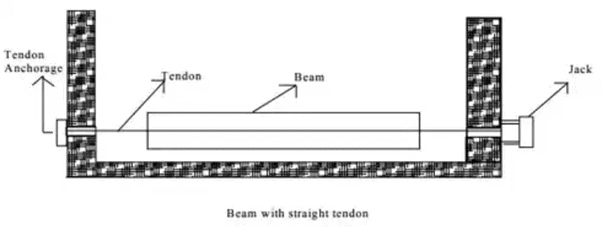
Prestressing System
- Post-tensioned system: In post-tensioning, the concrete unit is the first cast by incorporating ducts or grooves to house the tendons. When the concrete attains sufficient strength, the high-tensile wires are tensioned by means of jack bearing on the end of the face of the member and anchored by wedge or nuts.
Most of the commercially patented prestressing systems are based on the following principle of anchoring the tendons:
(i) Wedge action producing a frictional grip on the wire.
(ii) Direct bearing from the rivet or bolt heads formed at the end of the wire.
(iii) Looping the wire around the concrete.
Methods:
(i) Freyssinet system
(ii) Gifford-Udall system
(iii) Magnel blaton system
(iv) Lee-McCall system
- In prestressed concrete member, steel plays an active role. The stress in steel prevails whether the external load is there or not. But in R.C.C., steel plays a passive role. The stress in steel in R.C.C members depends upon the external loads. i.e., no external load, no stress in steel.
- In prestress concrete the stresses in steel are almost constant whereas in R.C.C the stress in steel is variable with the lever arm.
- Prestress concrete has more shear resistance, whereas the shear resistance of R.C.C is less.
- In prestress concrete members, deflections are less because the eccentric prestressing force will induce couple which will cause upward deflections, whereas in R.C.C., deflections are more.
- In prestress concrete fatigue resistance is more compared to R.C.C. because in R.C.C. stress in steel is external load-dependent whereas in P.S.C member it is load-independent.
- Prestress concrete is more durable as a high grade of concrete is used which is denser in nature. R.C.C. is less durable.
- In prestress, concrete dimensions are less because external stresses are counterbalanced by the internal stress induced by prestressing. Therefore reactions on column & footing are less as a whole the quantity of concrete is reduced by 30% and steel reduced by about 60 t 70%. R.C.C. is uneconomical for a long span because in R.C.C. dimension of sections are large requiring more concrete & steel.
Comparative Study: Pretension Vs Post-tensioned Member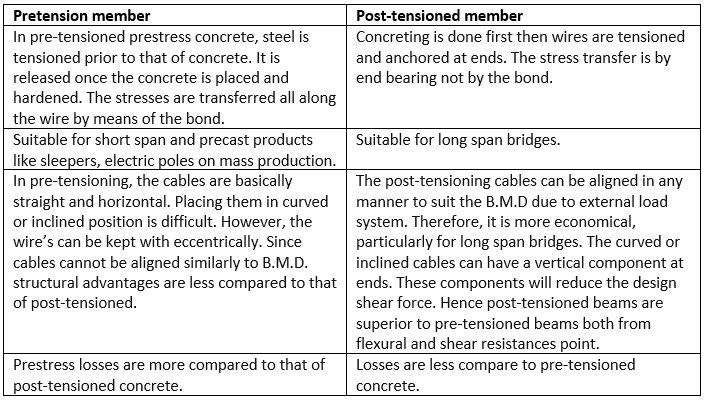
Basic Assumptions
1. Concrete is a homogeneous elastic material.
2. Within the range of working stress, both concrete & steel behave elastically, notwithstanding the small amount of creep, which occurs in both the materials under sustained loading.
3. A plane section before bending is assumed to remain plane even after bending, which implies a linear strain distribution across the depth of the member.
- Prestress Concrete is one in which there have been introduced internal stresses of such magnitude and distribution that stresses resulting from given external loading is counterbalanced to a desired degree.
Analysis of prestress and Bending stress
Following are the three concepts of analysis
- Stress concept analysis
- Strength concept analysis
- Load balancing method
- Stress concept Method
Following are the two cases for analysis
Case-(i): Beam provided with a concentric tendon: Let, P prestressing force applied by the tendon. Due to this prestressing force, the direct compressive force induced is given by, fa = P/A.
Let, P prestressing force applied by the tendon. Due to this prestressing force, the direct compressive force induced is given by, fa = P/A.
If due to dead load & external loads, the bending moment at the section is M, then the extreme stresses at the section due to bending moment alone is f0 = ±M/Z
Hence final stress at the extreme top edge = P/A + M/Z and stress at the extreme bottom edge = P/A - M/Z
Case–(ii): Beams with eccentrics tendon:
 (i) Direct stresses due to prestressing force = +P / A
(i) Direct stresses due to prestressing force = +P / A
(ii) Extreme stresses due to an eccentricity of the prestressing force
(iii) Extreme stresses due to bending moment = ±M/Z
Final stresses
Stress at top fibre = P / A - P.e / Z + M / Z
Stress at bottom fibre = P / A + P.e / Z - M / Z
By providing an eccentricity to the tendon, a hogging moment (P.e.) is developed which will produce stresses, which will counteract the stresses due to external bending moment. - Strength Concept method
Consider a beam of length l provided with a tendon at an eccentricity e. Suppose the beam is lying on the ground i.e. the beam is not subjected to any external load. Hence there is no external bending moment on the beam.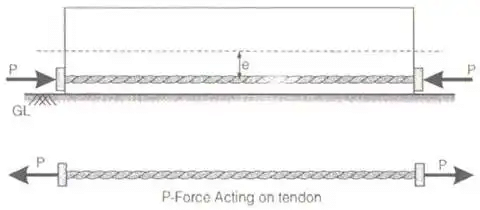
 The following equal forces are existing
The following equal forces are existing
(i) The P-force which is the tension in the tendon.
(ii) The C-force which is the compressive force acting on the concrete.
Stresses in concrete are produced entirely due to C-force.
In the absence of any external bending moment the C-force and P-force act at the same level. Line of action of P-force is called the P-line. The P-line is nothing but the tendon line itself. The line of action of the C-force is called the C-line or Pressure line. Hence in the absence of any external bending moment, the P-line and the C-line coincide.
Suppose the beam is subjected to a bending moment M, then the C-line will be shifted from the P-line by a distance 'a' called lever arm.
α = M / P = M / C
Extreme stresses in concrete are given by
- Load Balancing Concept
Prestressed Beam with Bent Tendon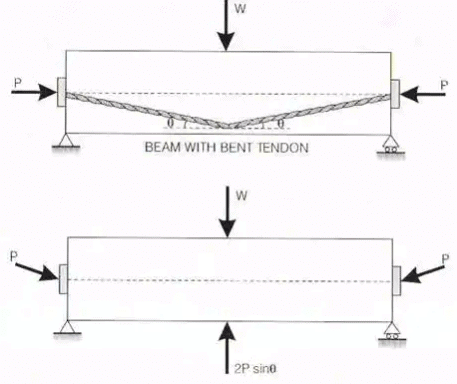 By providing bent tendons, the tendons will exert upward pressure on the concrete beam and will therefore counteract a part of the external downward loading.
By providing bent tendons, the tendons will exert upward pressure on the concrete beam and will therefore counteract a part of the external downward loading.
Considering the concrete as a free body. We find an upward force 2P sin θ.
The net downward load at the centre will be (W-2P sinθ)
The axial longitudinal force provided by the tendon = Pcosθ = P {since θ is small}
Direct stress on the section = Pcosθ / A = P / A
Net BM,
Where, w = dead load per unit length of the beam. Extreme fibre stress = P / A ± M / Z
It may be realized that the profile of the tendon should follow the shape of the bending moment diagram for the given external loads in the order it may offer considerable and effective upward forces. For e.g., if the loading on the beam is a uniformly distributed load, the tendon may be provided along with a parabolic profile.
Tendon with Parabolic Profile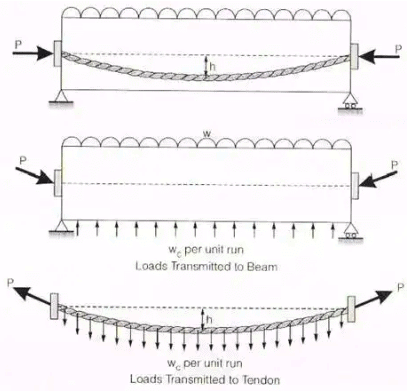 Let l be the span of the beam and h be the dip of the cable.
Let l be the span of the beam and h be the dip of the cable.
The cable will exert an upward udl = wC / m on the beam, but the cable will be subjected to a downward udl of wC per unit run.
Let V and H are vertical and horizontal components of P.
V = wcl / 2
The cable is an absolutely flexible member, therefore BM at every section of cable is zero. Hence BM at the centre of the cable is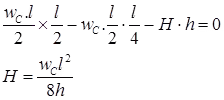
Since dip of the cable is very small, we can make an approximation
cosα = 1 and Pcosα = P
Now consider the beam, it is subjected to
(i) External load w per unit length
(ii) Upward udl transmitted by the cable = wC per unit length.
Net UDL = w – wC
Net BM at the centre 
Extreme stresses = P / A ± Net BM / Z
Losses of Prestress
The steel wires of a prestressed concrete member do not retain all the preliminary prestress. A certain amount of loss of prestress always takes place.
Losses may be classified as follows:
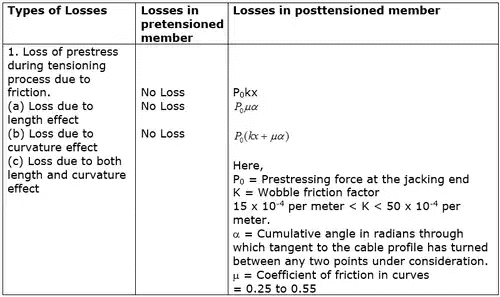

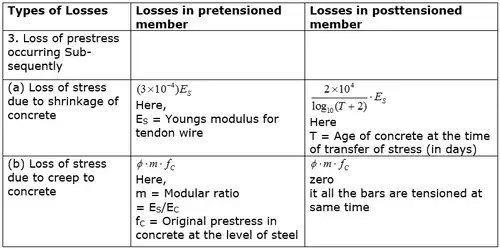
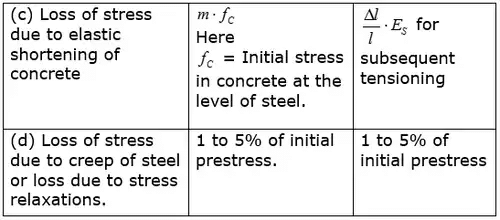
|
13 videos|54 docs|34 tests
|
FAQs on Prestressed Concrete - RCC & Prestressed Concrete - Civil Engineering (CE)
| 1. What is prestressed concrete? |  |
| 2. How does prestressed concrete differ from reinforced concrete? |  |
| 3. What are the advantages of using prestressed concrete? |  |
| 4. What are the common applications of prestressed concrete? |  |
| 5. How is prestressed concrete tested for quality control? |  |
















